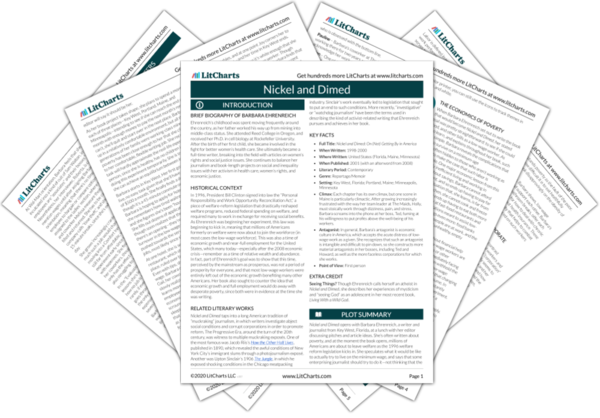Summary
Analysis
While Barbara wrote this book in a moment of prosperity and growth, it was published in 2001 just as the dot-com bubble was about to burst. People seemed shocked by the book’s revelation. It inspired a documentary and play, though it was also denounced as a “classic Marxist rant” by a group of conservative students at the University of North Carolina, which had assigned the book for freshmen, as well as by some North Carolina and state legislators. At the same time, housekeeping staff at the university was fighting for union recognition, and these employees invited her to campus.
In her afterword, written in 2008, Barbara seeks to situate the book’s publication within a particular historical moment: given the prosperity and economic growth of the time, it’s understandable that people would have been shocked at her portrayal of desperate low-wage working life. Barbara contrasts what she sees as a senseless critique with what she was really trying to accomplish – hence the example of the housekeeping staff.
Themes
If Barbara had to account for the book’s success among middle-class people, she’d say that they can identify with and imagine themselves as the main character. In addition, the book has been read among low-wage workers, many of whom have written her to tell her their stories. Three months after the book was published, a policy report found that 29 percent of American families lived in poverty.
Throughout the book, Barbara addresses a reader who seems to be someone much like herself – middle-class, educated, well-intentioned but ultimately woefully ignorant about the real lives of the working poor. She seems pleasantly surprised by the strong reaction from this group itself.
Themes
Seven years later, Barbara’s question is whether things have improved or worsened for people like those in the book. The former low-wage coworkers she’s managed to reach have struggled, reflecting a general downward trajectory for low-wage workers. It was revealed that Wal-Mart, in the early 2000s, had been abusing its workers by falsifying time records and locking workers into stores at midnight. Organizations have arisen to combat these policies and counter the opening of new stores, and in 2007 the company finally broadened its health benefits (while also seeking to transform its workplace from 20 to 40 percent part-time). Meanwhile, the Bush administration has been cutting public programs.
What Barbara reports about Wal-Mart won’t be surprising to the book’s readers, who have learned through Barbara about the struggles of people who hadn’t been paid for overtime or felt pressured into being highly flexible for shift times. At the same time, Barbara suggests that some progress has been made: the pressure groups combating Wal-Mart policies perhaps have provided a tool to counter the powerful corporate rhetoric that she’s discussed throughout the book.
Themes
In addition, in the previous few years there was an expansion of easy credit for the poor, including furniture scams and dodgy mortgages, which stood in for good wages but also contributed to a global financial crisis. Meanwhile, prices in food and rent have increased. However, “living wage” campaigns have strengthened enough to become a movement, and are beginning to win broader public support.
Writing in 2008, Barbara briefly mentions the financial crisis, the Great Recession – the most significant news at the time – in order to draw connections with her subject. She may have been able to last longer in Minneapolis with easy credit, but only at the expense of future stability.
Themes
Get the entire Nickel and Dimed LitChart as a printable PDF.

As she’s traveled around lecturing, Barbara has tried to show that you don’t have to go far to find the working poor—she’s traveled to Harvard and Yale to speak at campus protests about underpaid janitors and lack of child care. Business interests still resist paying a living wage, but over a hundred cities have passed living wage ordinances, without any falling into economic ruin. Still, these increases aren’t enough: in 2006 a worker had to earn on average $16.31 an hour to afford a 2-bedroom housing unit. Affordable housing is growing scarcer and transportation costs are increasing: Barbara argues that these issues will require action from the public sector.
In 2015, living wage laws were passed in major cities like Seattle and New York. At the time Barbara was writing the afterword, this was a nascent movement – clearly, it’s taken years to develop. She continues to stress, however, that economic and financial realities of wages are simply stacked against low-wage workers, something that she argues won’t change without public intervention.
Themes
To answer readers’ questions of “What can I do?” Barbara suggests joining a community living wage campaign, volunteering for a shelter or food bank, or supporting certain political candidates. But she argues that there is no one quick fix: our economic culture rewards the rich and punishes and insults the poor. Changing this will take at least a lifetime.
In the seven years after the book’s publication, Barbara received a great deal of support and comments: here she answers readers directly, encouraging them to show solidarity in a different way while still emphasizing the entrenched, deep-rooted nature of economic inequality.
Themes












